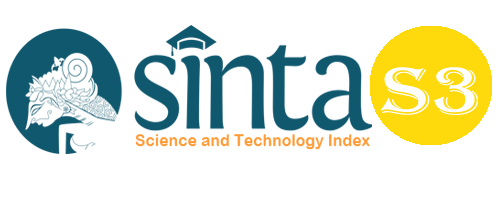Future-Anxious Commitment and Its Influence on Potential Human Capitals and Social Problems Anticipation With Personal Fides Awareness as Mediating Variabel
Abstract
South Sumatera is one of biggest city in Indonesia that has been developing in many kinds of infrastructures, not only in physical aspect but also in human resource aspect. One of trendsetter problems in that city are work status that are accustomed to having at professions like lecturers and teachers in South Sumatera generally and Palembang city specially. Many lecturers and teachers not only in state universities and state schools (like: elementary school, junior high school, and senior high school) but also in private universities and private schools have been having uncertain status that we can also say outsourcing lecturers and teachers since Indonesia Government decided a moratorium planning in recruiting candidates of public servants in Indonesia. It means, it will be big problems for lecturers and teachers in Indonesia (especially in South Sumatera), they will influence on public services (like: college students and students) even decrease potential human capital and other social problems because of lecturers’ and teachers’ uncertain status. Meanwhile in other countries (USA, England, Japan, New Zealand, Singapore, Germany, Korea, Philippine), outsourcing workers are a custom in those but it can not be implemented in South Sumatera because outsourcing workers in this city are not ready yet in their competencies, soft and hard skills, experiences, creative thoughts, internal motivations, independencies, and loyalty to the job. Besides that, there is custom in South Sumatera (Indonesia generally) that being an employee is a pride for themselves and their families even though the salaries are too low. This research had found two postulates to become novelties support motivation and commitment theoriesThe result of this research are there are strong influence of personal FIDES awareness on future-anxious commitment grades 0,98 (98%), strong influence of personal FIDES awareness on potential human capital grades 0,79 (79%), and strong influence of personal FIDES awareness on social problems anticipation grades 0,53 (53%). Personal FIDES awareness (PAFIDES) rises because of uncertain job status and job scarcity, and PAFIDES can not strongly and directly influence on social problems anticipation (SOCPRA) but it will be strongly if it indirectly influences on SOCPRA by using mediating variable called future-anxious commitment.
Keywords
Full Text:
PDFReferences
Allen, N. J., & Meyer, J. P. “The measurement and antecedents of affective, continuance and normative commitment.” Journal of Occupational Psychology, 63, 1-18. (1990)
Augusty Tae Ferdinand, “Structural Equation modeling.”, (Third edition), Diponegoro university Publisher, 2017.Belinda Renee Barnett, Lisa Bradley, “The impact of organisational support for career development on career satisfaction,”, Emerald Group Publishing Limited 1362-0436, 2007
Connell, J. P. & Ryan, R. M. “A Developmental Theory of Motivation in the classroom Teacher Education Quality,” 11, pp. 64-77. 1984
Connell, J. P. & Ryan, R. M. “ A Developmental Theory of Motivation in the classroom.” Teacher Education Quality, 11, pp. 64-77, 1984
Cordova, D. I., & Lepper, M. R. (1996). “Intrinsic motivation and the process of learning: beneficial effects of contextualization, personalization, and choice.” Journal of Educational Psychology, 88, 715–730. http://dx.doi.org/10.1037/0022-0663.88.4.715, 1996
David G. Coolings and Geoffrey Wood, “Human Resource Management, A Critical Approach.” Routledge 2 Park Square, Milton Park, Abingdon, Oxon OX14 4RN, 2015.
Department of Labor Women’s Bureau, “Employment status of women and men in 2006.” Retrieved from http://www.dol.gov/wb/factsheets/QfESWM06.htm, 2005
Durkin, M., & Bennett, H. , “Employee commitment in retail banking: Identifying and exploring hidden dangers.” International Journal of Banking, 17(3), 124137. (1999)
Feirong Yuan and Richard W. Woodman, “Innovative Behavior in The Workplace: The Role of Performance and Image Outcome Expectations.” Academy of Management Journal, 2010, Vol. 53, No. 2, 323–342., 2010
Filak, V. F. & Sheldon, K. M. “Student Psychological Need Satisfaction and College Teacher-Course Evaluations.” Educational Psychology, Vol. 23, No. 3, pp. 235-247. (2003)
Gary Jon Springer, “A Study of Job Motivation, Satisfaction, and Performance among Bank Employees,” Journal of Global Business Issues, 2015
Geert Hofstede, “Motivation, Leadership, and Organization: Do American Theories Apply Abroad?”, Organizational Dynamic, Summer 1980.
Hair, J.F Anderson, R.E., Tatham, R.L. & Black, W.C, “Multivariate Data Analysis (Fourth Edition), New Jersey, Prentice Hall, (1995)
Horwitz, M. F., Heng, T.C., & Quazi, A.H. “Finders, Keepers? Attracting, motivating and retaining knowledge workers.” Human Resource Management Joumal, Vbl 13 No 4, 2003, Pages 23-44, 2003
Imam Ghozali (2008), “Strucctural Equation Modeling, Concept and Application by Using AMOS 16,0 “, Diponegoro University Publisher, 2008.
Joan Marques, “Turning Inward to Connect Outward: Interbeing as motivational Path in today’s Workplace”, personhood press, 2014
John P. Meyer and Natalie J. Allen, “A Three- Component Conceptualization of Organizational Commitment.” Human Resource Management Review, 2001.
John P. Meyer, David J. Stanley, Lynne Herscovitch, and Laryssa Topolnytsky, “Affective, Continuance, and Normative Commitment to the Organization: A Meta-analysis of Antecedents, Correlates, and Consequences.” Journal of Vocational Behavior 61, 20–52 (2002)
Luthans, F. “ Organizational Behavior.” 8th ed Boston: Irwin McGraw-Hill, 1998
Meyer, J. P., & Allen, N. J., “A three-component conceptualization of organizational commitment.” Human Resource Management Review, 1, 61-98. 1991
Morrow, P. C., & Wirth, R. E. “Work commitment among salaried professionals.” Journal of Vocational Behavior, 34, 40-56., 1989
Nunnaly, J , “Psychometric Method,” New York. Mc. Graw Hill 1967.
Nwachukwu Prince Ololube , “Teachers Job Satisfaction and Motivation for School Effect iveness: An Assessment,” University of Fin Land, 2016
Ray, J. J. “The Comparative Validity of Likert, Projective and Forced Choice Indices of Achievement Motivation.” Journal of Social Psychology, 111, 6372, 1980
Roxanne Helm-Stevens and Orlando Griego, “A Path Analysis Model of Intrinsic and Extrinsic Academic Motivation Engagement in Service Learning.” Review of Business Research, Volume 9, Number 1, 2009
Scermerhorn, Hunt, and Osborn “Organizational Behavior.”, John and Wiley, Inc, 2010
DOI: https://doi.org/10.33258/birci.v1i3.56
Article Metrics
Abstract view : 181 timesPDF - 203 times
Refbacks
- There are currently no refbacks.

This work is licensed under a Creative Commons Attribution 4.0 International License.

This work is licensed under a Creative Commons Attribution-ShareAlike 4.0 International License.

_.gif)

















_.gif)



